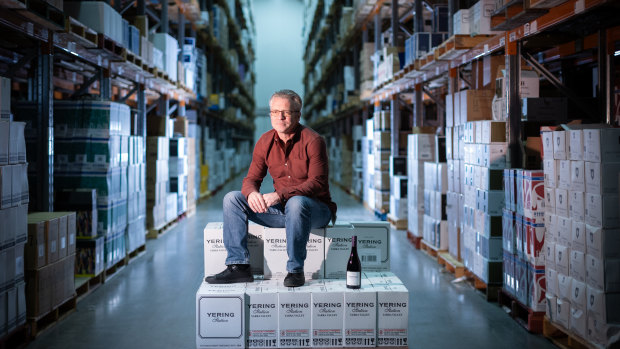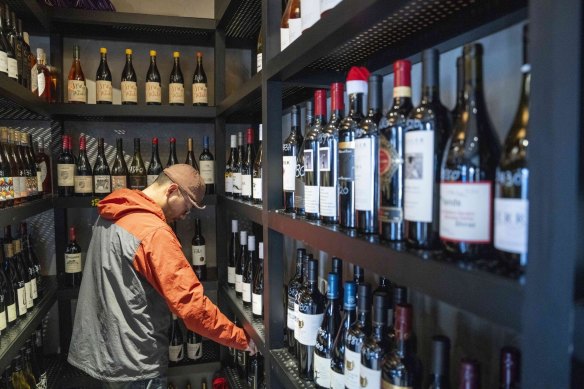When the Chinese government finally lifted crippling tariffs on Australian wine four weeks ago, the Rathbone Wine Group still had containers of bottles that had been sitting on the wharfs for months, waiting to be cleared by customs.
The end of the tariffs – which were as high as 220 per cent for the past three years – also terminated the burdensome red tape for the handful of Australian winemakers who were exporting small quantities to China, and Rathbone’s premium wines soon after made it onto the Asian mainland.

Trade with China has been tougher than Darren Rathbone initially anticipated, after the country said it would drop tariffs on Australian wine last month.Credit: Jason South
“We had seen containers of wine sitting on the wharfs for extended periods, while Chinese customers were slow to process Australian wines going through the ports,” Rathbone chief executive Darren Rathbone says.
“There’s still a reasonable amount of red tape, but it’s gone back to what it was pre-tariffs.”
A month on, Rathbone is cautiously optimistic about the family business’ foray back into China, where almost half of Australia’s worldwide wine exports were headed before 2020, when Beijing imposed tariffs following multiple diplomatic disputes over human rights, national security and COVID-19.
The Chinese Ministry of Commerce accused Australian winemakers of dumping wine in the Chinese market at cheaper prices, forcing out competition from local vineyards. The allegations were rejected by Australian exporters and the federal government.
Almost 30 years ago, the Rathbone Wine Group bought Yering Station Winery – Victoria’s first vineyard, established 1838 – before acquiring Mount Langi Ghiran in Victoria’s Grampians region and Xanadu in Margaret River, Western Australia.
The company entered the Chinese market in 2007, at the beginning of Australia’s growing trade relationship with Beijing; by 2019, 15 per cent of its revenue was derived from China exports.
“When I first started travelling up to China in 2007, Chinese consumption of wine had a lot to do with status, and there wasn’t really a good understanding of flavours of wine; they saw it as a strange Western thing … to put on the table when they were eating Western food,” Rathbone says.
“When a lot of the younger Chinese were studying abroad, while living here, they developed a taste for Australian wine;, and when they returned to China, they brought that education with them, introducing their understanding of wine … that was a big part of Australia’s success.”

Wine for sale at a store in Shanghai after China lifted sanctions against Australian wine.Credit: Bloomberg
Although China exports dwindled after the introduction of the tariffs, Rathbone says he still maintained strong relationships with his Chinese customers, partly in the hope his business could bounce back swiftly when they were lifted.
But, a month on, trade has been tougher than he initially anticipated, and he has wound back his expectations for the China market. He now hopes China would eventually make up 5 per cent of Rathbone’s revenue within two years.
“In the lead-up to the tariffs being dropped, where there was a lot of speculation, I hoped we would get orders on the expectation of it being dropped, but that didn’t occur. It wasn’t until the absolute confirmation that orders came,” Rathbone says.
“There is a lot of conservative apprehension with Chinese customers. Their economy is not as strong as five years ago, so there’s a hesitancy to place big orders. And having been out of the market for some time, Chinese winemakers have filled the market, and it also feels like some South American producers have taken advantage of us exiting the market.”
If international competition before 2020 seemed tight, it has only become worse, compounded by shipping problems dating back to the pandemic, growing tensions in the Middle East and a drying Panama Canal.
Rathbone says it is not unusual for his wines, travelling all over the world, to be either stuck on a ship or in containers at ports for long periods. He says he has needed to book ships for exports with at least a month’s notice, compared to a week in advance before the pandemic.
“However, Chinese customers are still very, very positive, and they’re excited to be trading again,” Rathbone says.
“They still see that Australian wine is well sought after by the consumers in China, and there’s still a positive reputation for Australian wine.”
The Business Briefing newsletter delivers major stories, exclusive coverage and expert opinion. Sign up to get it every weekday morning.